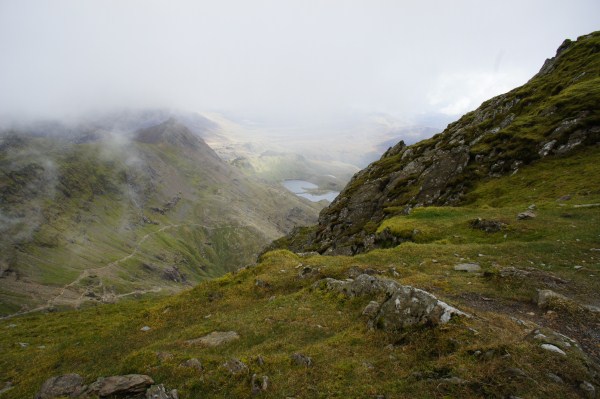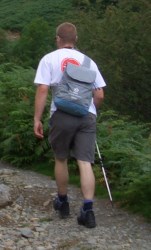Footwear
These are steep walks. As well as walking steep slopes you will have to do a fair degree of climbing and clambering - some parts over scree and boulders rather than a nice smooth path. And coming down is even harder on the feet, knees and ankles than going up although it will feel easier as you won't be so out of breath.
Good footwear is essential - if the soles of your shoes are not thick enough you will eventually feel every little stone on the path, and will be in agony. Many a toe nail has been lost because of shoes which feel comfortable on the flat, or going up, but are correctly fitting to ensure you can come down without your toes banging against the end of the shoe! See our guide for buying walking boots.

Join us on
Please visit the Sitemap to see the full range of information on this site
MountainWalk.co.uk is produced by Trish Haill Associates Copyright
Have you climbed Ben Nevis, Snowdon or Scafell Pike? Or taken part in the Three Peaks Challenge? Or have a special walk you'd like to share? We'd love to here from you! Join us on
or Send us an email.
or Send us an email.
Equipment and Essentials for Hiking/Walking on Britain's Mountains
Serious Walks - Hiking Equipment List
Now don't let's beat around the bush. Ben Nevis, Scafell Pike, Mount Snowdon and other British mountain ranges are serious walks. Although they can be tackled by most people, to do so safely and in a degree of comfort there are some pre-requisites such as having the correct mountain walking equipment.
Often holiday makers decide to climb these mountains on a whim - it's a sunny day, so they start off in shorts, T-shirt and sandals. The summit will be very much colder than when they started, and the ground far more challenging to walk across. On top of that, they'll be miles away from their car and it might start to rain...
What started off as a pleasant family walk can quickly turn into a nightmare. Being properly prepared will make your day far more enjoyable!
On this page we've put together a brief description of what you ought to consider as part of your mountain walking equipment.
Other pages on this site give more specific information about what you should be looking for when buying your equipment for hiking and mountain walking.
Guide for Buying Walking Boots
Why use Walking Poles and Which to Buy
Good Rucksacks for Walking
Maps, Compasses and Other Useful Items
Wet Weather Wear - Waterproofs
Why should you buy a GPS
Winter Walking Equipment
Other pages on this site give more specific information about what you should be looking for when buying your equipment for hiking and mountain walking.
Guide for Buying Walking Boots
Why use Walking Poles and Which to Buy
Good Rucksacks for Walking
Maps, Compasses and Other Useful Items
Wet Weather Wear - Waterproofs
Why should you buy a GPS
Winter Walking Equipment

You will find if you buy online before you go you will get the best deals on prices. There will be camping and outdoor shops in villages and towns around all the three major peaks, but often the prices will be more expensive.
Where to buy Hiking and Walking Equipment?
Ben Nevis and Scafell Pike will take you at least 6 hours and probably a lot more. If you think about walking in the same pair of shoes for a whole day you will understand they need to fit well so you don't get blisters. Hiking or walking boots give support to your ankle better than shoes, but may also rub worse if they are not the right shape for your leg.
You don't need to pay a fortune for good sturdy walking footwear, but remember these three tips:
1. Make sure they fit well and there is enough room for your toes - if your toes are too near the end of the shoe coming down may make your toes repeatedly bash against the shoe and result in a lot of bruising and even lost toe nails!
2. Make sure that the sole is thick so you will not feel the stones on the path.
3. Make sure the shoes or boots are very comfortable. If possible buy them well before you attempt the climb and wear them in.
Tips for staying comfortable in your boots
Push your heel as far back in the shoe or boot as you can before tying the laces.
Wrap your laces round the top cleats from top to bottom, rather than bottom to top. This enables you to tie a tighter knot.
Before coming down the mountain, re-tie your laces, this time as tightly as you possibly can. Stop and re-tie your laces at intervals during the descent, this will help keep your toes away from the end of the boot or shoe, and will help save those precious toe nails!
Push your heel as far back in the shoe or boot as you can before tying the laces.
Wrap your laces round the top cleats from top to bottom, rather than bottom to top. This enables you to tie a tighter knot.
Before coming down the mountain, re-tie your laces, this time as tightly as you possibly can. Stop and re-tie your laces at intervals during the descent, this will help keep your toes away from the end of the boot or shoe, and will help save those precious toe nails!
Clothing
This is highly dependant on the time of year and the weather (although I do not recommend non serious walkers to attempt either of these walks in poor visibility or bad weather).
You will need to wear lightweight clothing (lets face it, the less weight you need to carry the better!), and lots of layers. Even if it is perfectly sunny when you start out you should try and take a jumper and waterproof with you. The weather can turn very suddenly, and it is often several degrees colder at the summit than at the bottom so you may start off wearing a tee shirt, but by three quarters of the way up have had to put on a jumper and jacket as well. Even though it may not actually start raining, you may find yourself climbing up through low cloud - if you have no waterproof you will get uncomfortably soggy. It's also useful to take a hat - you'll be out in the elements for a long time, and don't want to get sunstroke or have rain on your head all day. See our guide to waterproof clothing.
Essentials
Take water and snacks with you, and water as well! Oh, and some water too!
Okay, put in a bit of a silly way, but it is a long hard slog, and you will become very thirsty and dehydrated if you are not prepared.
We are non serious walkers, so are not attempting record times, so bring a picnic along. You will find that the higher you go the more exhausted you will be, so will have a lot of stops. A packet of crisps, a bar of chocolate will give you that extra stamina to go on for a few more steps. As you need the top of the mountain you will probably be going on will power alone, so make sure you have something for energy. Glucose tablets are ideal - or for Scafell Pike why not take some of the local Kendal Mint Cake? It's an ideal energy booster!

Maps, compass or more modern means....!!
Take a good map with you - the Ordnance Survey maps can now be custom made to centre around the exact area in which you are proposing to explore. If you are taking one of the well travelled routes maps will be available in many of the local shops. You'll also need to take a compass with you as well. Summits are often covered by cloud and without a compass you may have difficulty trying to find which way to come down. Make sure you know how to use a map and compass before you go.
If you are likely to be travelling off the main routes, or in poor weather, a GPS for walkers is a great tool. You will always know where you are with one of these!
See our guide to buying maps, compasses and GPS.
Walker equipped with sturdy boots, rucksack and walking pole
Emergency Equipment
Whilst these walks are suitable for less experienced mountain walkers, it's always best to be prepared for an emergency. Survival blankets cost little and weigh next to nothing, but if you do get lost in cloud, or mistime how long it's going to take you to come down the mountain at night these items will be a godsend. Likewise you should have a torch with you - ideally one that can flash to show your position in case you have an accident. It's always advisable to take a fully charged phone with you.
Optional items
You will see many walkers well equipped for their walks - even if you only intend to do one serious walk this holiday, you may like to treat yourself to something which will not only help you, but also make you look more the part.
A good lightweight rucksack is useful for carrying your provisions. Although people, believe it or not, resort to using carrier bags, these not only will get in the way when you need both hands to clamber over rocks, they also are a dead giveaway that you are a real novice at this. A rucksack leaves your hands free, and carrying the weight centrally on your back keeps you balanced.
Another extra used by many people is the walking pole or poles. Lightweight aluminum telescopic walking sticks can be compressed and carried in or on your rucksack, and can be used either for general balance, or as a real aid when going over the steeper parts. For the novice walker these are a real Godsend, giving you a helping hand when you most need it.
Water bags with a drinking tube attached help you look the part and also enable you to keep drinking whilst on the move. If you like this idea treat youself, but remember that you will probably need to have numerous breaks anyhow, so getting a bottle of water out of your rucksack will not hold you up too much!
See also
Guide for Buying Walking Boots
Why use Walking Poles and Which to Buy
Good Rucksacks for Walking
Maps, Compasses and Other Useful Items
Wet Weather Wear - Waterproofs
Why should you buy a GPS
Winter Walking Equipment
Guide for Buying Walking Boots
Why use Walking Poles and Which to Buy
Good Rucksacks for Walking
Maps, Compasses and Other Useful Items
Wet Weather Wear - Waterproofs
Why should you buy a GPS
Winter Walking Equipment
